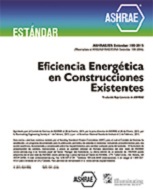Description
Measurements of exchange flows~through doorways were made in a test house and in a geometrically similar 1:20 scale model A tracer gas was used in the full-scale study to determine the volume of air exchanged during Opening-closing cycles over a range of temperature differences from O°C to 34°C across the doorway. The 1:20 model simulation utilized salt water and fresh water to simulate the density difference caused by temperature in full scale.
Total exchange volumes were correlated with fractional density difference to develop an exchange model for buoyancy-driven flow during both the steady flow period when the door was fully open, and for the transient flow period when the door was opening and closing. When door swing pumping was negligible, a quasi-steady counterflowing jet model gave a good estimate of flow rate if a time-varying door orifice size was used. The orifice coefficient, which accounts for the effects of viscosity, streamline contraction and mixing between the inward and outward counterflows, varied between 0.6 at large temperature differences and 0.4 at zero temperature difference.
The experimental data were used to determine the nonlinear combination of pumping caused by the swinging motion of the door and the buoyancy-driven counterflow caused by the ternperature difference across the doorway. For typical swing speeds it was found that the purnping exchange could be neglected entirely above a temperature difference of 3° C to 5° C. A t a temperature difference of zero the volume pumped increased linearly with the speed of the moving door, with a typical exchange volume of about 50% of the swept volume of the door.
Citation: Symposium, ASHRAE Trans., vol. 95, pt. 2
Product Details
- Published:
- 1989
- Number of Pages:
- 10
- File Size:
- 1 file , 1.3 MB
- Product Code(s):
- D-27230




